Ate: description, types, cultivation and reproduction
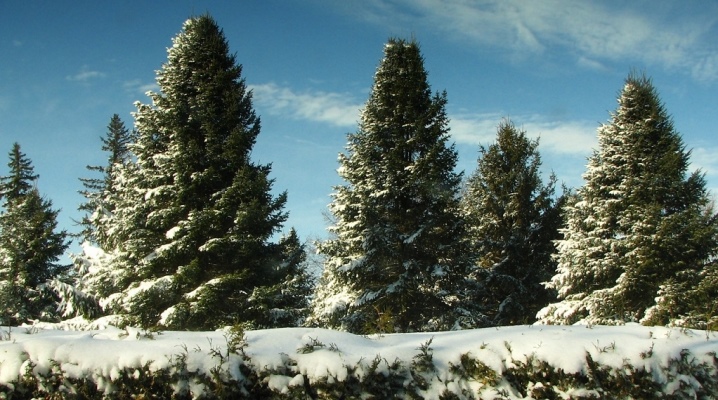
Deciduous plants are beautiful and graceful. However, coniferous crops undoubtedly deserve attention. Among them is the spruce, which must be known to all gardeners and decorators.
Description
The height of spruce can reach a maximum of 50 m. But in most plants it is no more than 30 m. The structure of spruce trees and shrubs implies one thing in common - the presence of acicular perennial leaves. The shape of the spruce crown is close to a perfect cone. If the conditions for development are unfavorable, the plant takes on a dwarf plant.
The length of the needles ranges from 0.01 to 0.025 m. Each needle lives at least 6 years. The needles have a spiral arrangement. These leaves are tetrahedral, one by one, placed on each leaf pad one by one. A separate discussion deserves such a characteristic of the spruce as the color of its needles.
The widespread belief that Christmas trees are always painted the same color is completely wrong. The color of the needles changes depending on the season. Along with green, there are also yellow and even multi-colored needles. Dark green tones are predominantly dominant.
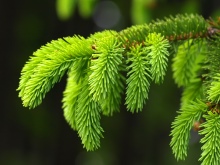
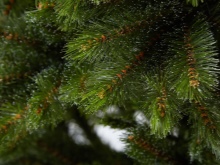
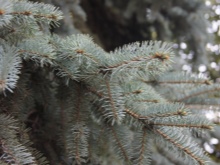
All spruce trees with a trunk height of more than 3 m fall into the category of large-sized trees. It is these plants that are most widely used in landscaping public and private spaces. The technology of planting (transplanting) large-sized spruce trees is the same as that of other conifers. Speaking about what a tree looks like, it is imperative to indicate that the size of the spruce increases significantly in the first 15 years. At this time, the plant forms a trunk and has a taproot.
The wood of the plant contains little resin, especially when compared to pine wood. It is painted white with a slight touch of golden color. The cones are slightly pointed, resembling an elongated cylinder. The seeds ripen by mid-autumn. Spruce seeds blown by the wind remain viable for 8-10 years. At the moment, the existence of at least 45 species of spruce has been confirmed.
Its crown density is greater than that of a pine, since this plant is one of the shade-loving species. The diameter of the spruce crown varies from 6 to 8 m. In some species, it has a pointed top. The crown can have both loose and dense structure. The trunk diameter of the most developed trees varies from 1.2 to 2.4 m.
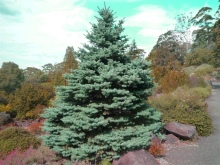

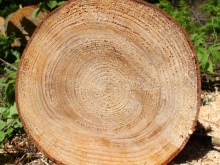
Features of the root system
The depth of the spruce roots is noticeably less than their width. Almost 86% of the roots are located at a depth of 0.01-0.09 m. A dense interlacing of parts of the root system is characteristic. Only 2% of the roots reach the level of 0.3-0.5 m. The number of large, well-developed roots is even less there.
The greatest recorded depth of the root system of spruce reaches 1.65 m. Almost always, it makes its way into the depths of the cavities left after the rotting of the underground part of the plants or along the passages laid by soil animals. The roots located closest to the surface receive abundant mineral components from the earth.
The smaller each root is, the darker it will be. The surface of the roots is covered with thin plates that peel off easily.
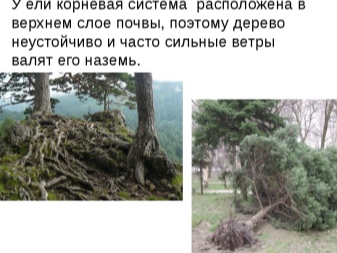

How and how much is growing?
Young spruce trees grow rather slowly. In the early years, they add a few centimeters.Only after good rooting does the plant begin to develop faster and gradually makes up for the lost height. The annual growth rate of developed forms can vary from 0.08 to 0.5 m. Of course, in dwarf forms, this figure is much less.
On average, it takes 6-7 years for a tree to grow by 1 m. But you need to understand that these indicators apply only to plants that develop from scratch. If you do not engage in dubious experiments and take ordinary seedlings of decent quality, you can achieve an excellent result in 10-12 years. As for the lifespan, it is as follows:
- in the European species - from 300 to 400 years;
- in prickly - from 400 to 600 years;
- Siberian - at least 300 years old;
- in the Alaskan variety - up to 250;
- for black spruce - up to 350 years.

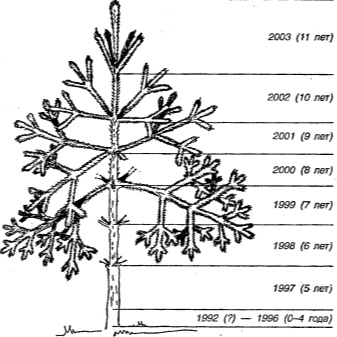
Views
It is appropriate to start a review of the family with the Scandinavian spruce. This plant can only be grown in very cold climates, at least 63 degrees north latitude. Its characteristic feature is its relatively slow growth. Because of it, the wood acquires a particularly dense, strong structure. The Scandinavian look is very popular not only in garden design, but also as a source of building materials.
For an alpine slide, for example, the Nidiformis tree is ideal. Its crown, which looks like a nest, has a recess in the middle. Adult specimens of cushion spruce reach a maximum of 0.5-1 m in height. The needles on the Nidiformis tree are dark green in color. Also worthy of attention is "Alberta Globe" - a product of a natural mutation of Canadian Christmas trees.
This variety was officially described and cataloged thanks to the efforts of the Dutch breeder Streng in 1967. It is actively used in the design of squares and gardens around the planet. Shrub "Alberta Globe" has a height of 0.7-1 m with a crown girth of up to 1 m. Annual growth does not exceed 0.1 m in height and 0.04 m in breadth. Despite the density, the shoots are relatively thin and hardly prickly, the cones do not exceed 0.05 m in length and have a light brown color.

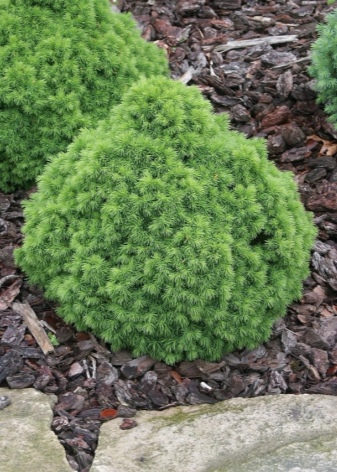
As for room spruce, you must immediately make a reservation - this is not just one variety, but a whole group of varieties. They are united only by their small size and suitability for growing in pots. Strictly speaking, it is unreasonable to keep even adapted species of Christmas trees in the room, they are uncomfortable there because of the microclimate. The solution is to breed such plants on balconies and open terraces. In this case, you will also have to take care of a sufficient degree of warming of the culture in severe frosts. As for fir trees with soft needles, they did not eat at all, but firs, mountain pines, thuja or larch trees.
Creeping spruce "Lorelei" has an arc-like barrel. The lower shoots spread directly along the ground. The plant "creeps" after grafting into the root collar. The branches rise up to a maximum of 0.6 m. "Lorelei" grows well both in the bright sun and in partial shade.
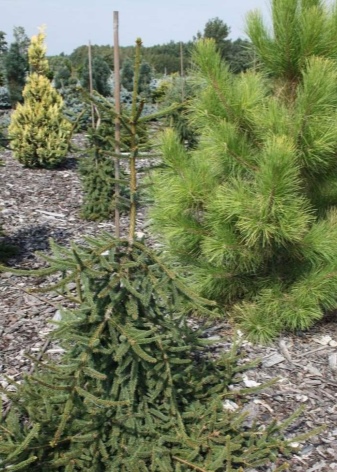
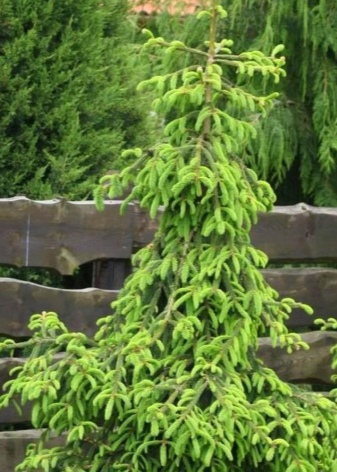
Caucasian, or otherwise - eastern spruce, has a trunk diameter of about 2 m. The crown reaches 15-20 m in diameter. Young shoots are slightly shiny, yellow-gray or slightly reddish. The pinnacle of young Caucasian Christmas trees often exudes resin beads. The buds are similar in shape to an egg and do not secrete resin.
The needles are slightly flattened. It is characterized by a four-sided shape with a round tip. The needles are moderately hard and in most cases have a size of 0.5 to 0.9 cm. In addition to the Caucasus, this plant inhabits Turkey and the northern regions of Asia Minor. Caucasian spruce forms both purebred and mixed forests on shaded slopes.
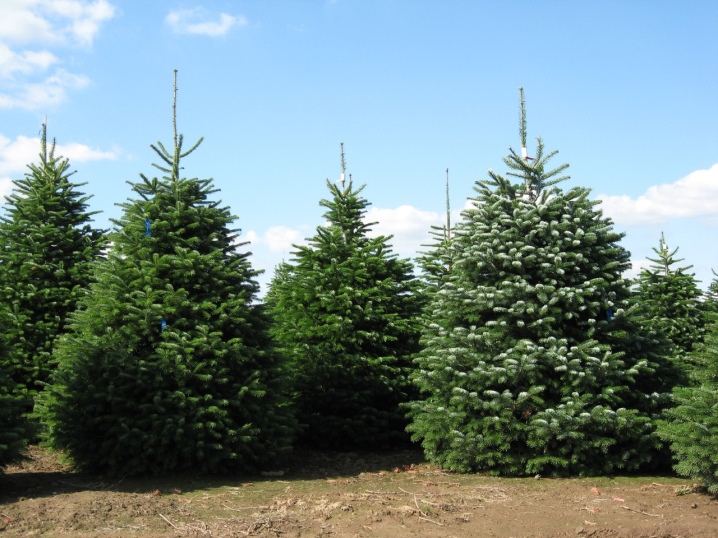
Spruce "Beloboka" fully justifies its name - it is a pretty tree of modest size with white tips. The height of the plant will be a maximum of 2-3 m. Spring shoots are colored cream or straw. The culture was bred in Poland in the 1930s. The variety is suitable for both group and single plantings in any places with a suitable climate.
It is also used by:
- in landscaping terraces;
- in the formation of rock gardens;
- in rock gardens.
There is also a pot (container) version of "Beloboki". For a year, the growth is no more than 0.12 m. A pronounced trunk is not formed in the first years of development. As it grows, it takes on the shape of a wide cone. Thick needles reach 0.03 m in length, they are arranged in a radial pattern.
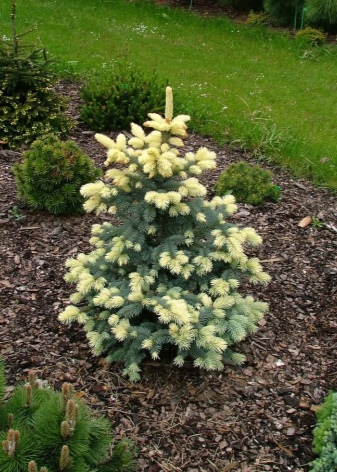

Many gardening and landscape design lovers are interested in spruce trees with long needles. The prickly blue spruce fully corresponds to this description. Its atypical color and one of the longest needles in this genus make the plant an ideal candidate for any landscape composition. The thorny blue spruce perfectly tolerates the harsh winter and the harsh environmental conditions of large cities. The height of a tree can reach from 20 to 35 m, while by the age of 12 it is up to 4 m.
The cones of the thorny blue spruce are placed in the upper part of the crown. They are characterized by leathery or stiff scales. The species in nature inhabits the temperate climatic zone on all continents. A positive feature of the culture can be considered that it almost does not need fertilizers. Especially highly regarded grade "Glauka".
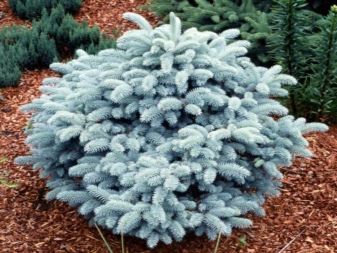
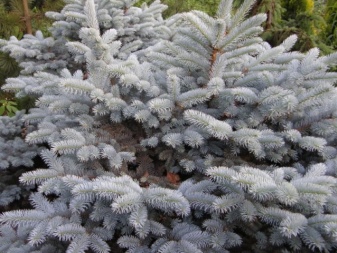
A striking example of a pyramidal tree is "Kupressina". It forms a tall trunk and branches densely. Growth in comparison with other conifers is very fast (2.5-3 m by 10 years of age). The plant tolerates a powerful snow load without any problems. The lowest permissible temperature in winter is -34 degrees.
"Nana" also has a pyramidal crown. A dwarf (no more than 1.5 m) shrub was bred by French breeders in the middle of the 19th century. The plant is characterized by overcrowding of branches and their uneven development. The needles are spiny and relatively short. In the trade, the variety "Nana" is often referred to as Pygmaea.
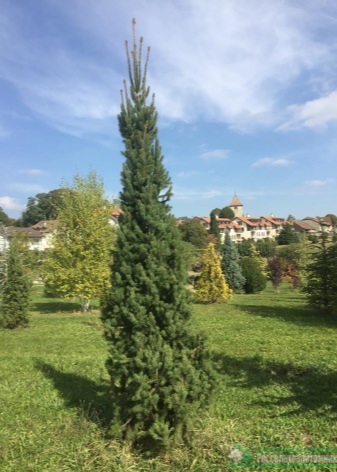
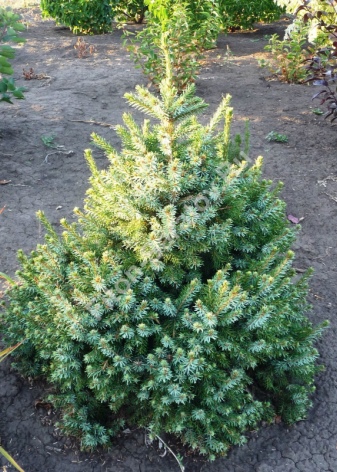
Sometimes there is a mention of a certain cedar spruce. But in fact, this name is absolutely illiterate: cedar and spruce are completely different trees, and even varieties with such a name have not been recorded in any serious sources. But the Norwegian variety is quite real. It is a common pot culture. Its attractive advantage is that the tree has the shape of a regular cone, topped with a fluffy top.
If we also take into account the grace of thin branches elongated in length, it becomes clear how good such a Christmas tree looks at home. The plant is suitable for home decoration both in itself and together with other cultures.
Strictly speaking, the Norwegian spruce is one of the variants of the European type. True, it is subjected to careful formative pruning - otherwise a good result cannot be achieved.
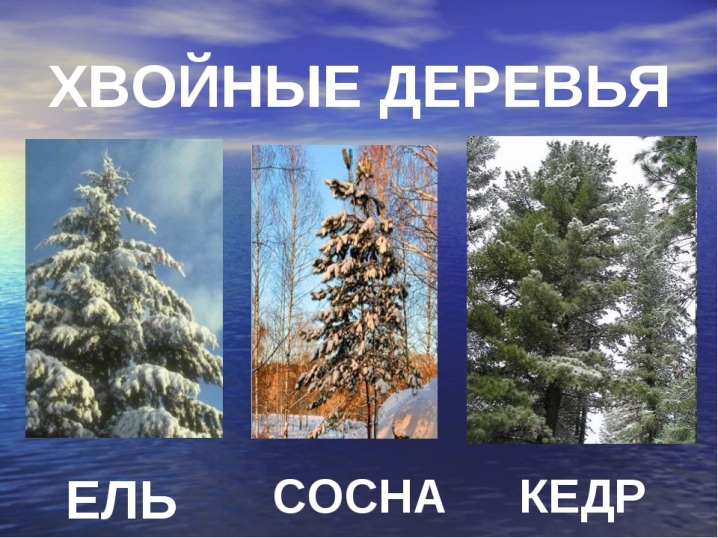
Of course, the variety of spruces does not end with the listed options. It is useful to at least briefly describe other varieties of this coniferous tree. Gray, it is Canadian, spruce is popular. This plant is distinguished by its height and slenderness, has green-gray needles. Russian gardeners and landscape designers appreciate it for its resistance to winter conditions.
Low-growing subspecies of Canadian fir trees "Konica" gardeners have been eagerly buying for many years now. The Tien Shan spruce, or Shrenk spruce, reaching 45 m in height, can become a decoration of vast areas. This tree is characterized by a tapering crown and pale blue needles. In nature, Shrenk spruce inhabits over 90% of the Tien Shan, as well as the Dzungarian Alatau. Her wood is not only beautiful, but also very good as a building material. At the same time, the key value of the plant remains its ability to strengthen crumbling mountain slopes and moving earth layers.
The suitability of Schrenk spruce trees for water protection plantations in mountainous areas has also been proven.
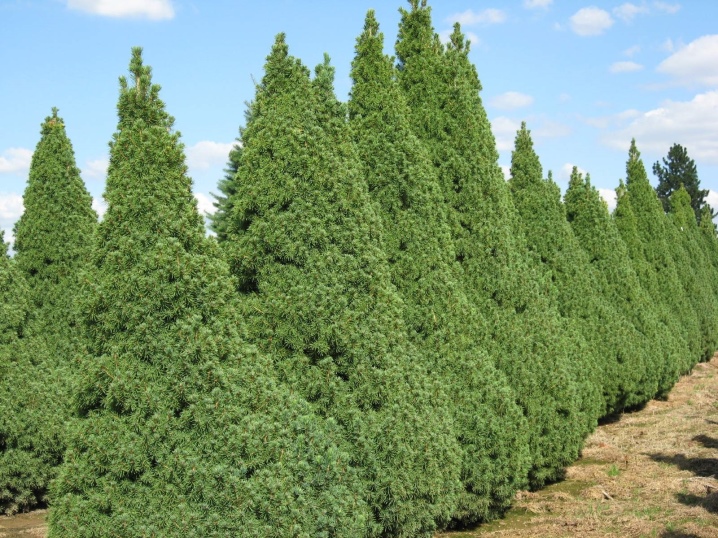
It also grows in the mountains Serbian (also called Balkan) spruce. This species develops excellently in the middle zone of the Russian Federation, it can reach 55 m in height.
Its external feature is a spectacular looking crown in the form of a narrow cone.The top is thick for a very long time. In the upper part, the needles are dark green, and in the lower part they have a whitish color. Ayan spruces can be seen in nature in Kamchatka, Sakhalin, and the Kuril Islands. Sometimes they are found in other parts of the Far East.
This plant is characterized by:
- resistance to winter;
- crown in the form of a wide cone;
- attractive looking two-tone needles.

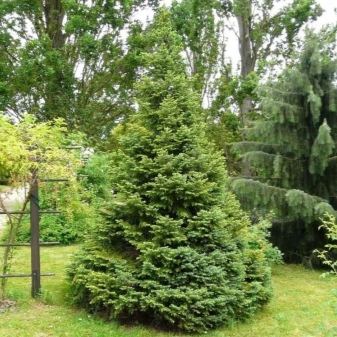
Originating from North America the Brevera spruce also tolerates frosty weather well. The usual height of trees reaches 10-15 m. However, some outstanding specimens rise up to 35 m. The crown diameter can be 5-6 m. Very graceful branches of the second order are noted, located 1-3 m below the main shoots.
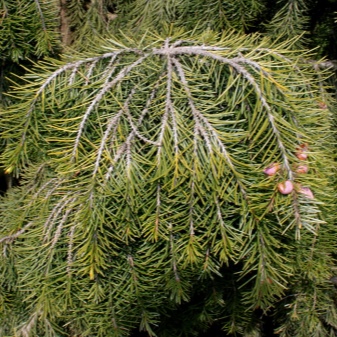
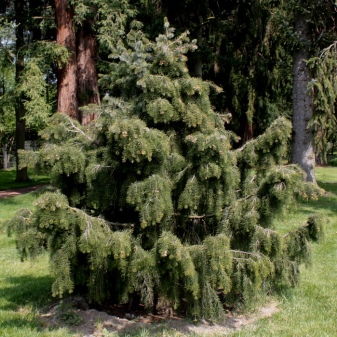
How to choose?
In order for a street spruce in the garden or near the house to please, you must very carefully select a suitable plant. Experts advise to go to nurseries in winter. It is then that it will be possible to appreciate all the charm of the plant itself, not shaded by herbs and other crops. In addition, with the onset of cold weather, most nurseries are ready to make discounts on preliminary spring orders. The most important factor in the selection will be the assessment of the winter hardiness of a particular crop.
In recent years, the best European varieties in terms of resistance to cold are not inferior to varieties of domestic selection. However, it is better to still focus on local achievements - they are better adapted to the vagaries of weather in the off-season. It is imperative to be interested in how resistant specific crops are to sunburn in the spring. If these burns are likely, you will have to hide the plantings from the sun at the end of winter.
Experiments should not be abandoned. In some cases, trees on high boles or specimens with drooping branches turn out to be quite appropriate decoration of a summer cottage. In order to embody the spirit of the New Year holidays as accurately as possible, to comply with classical customs, it is advisable to choose varieties with a trunk and crown that are as close as possible to a cone in shape.
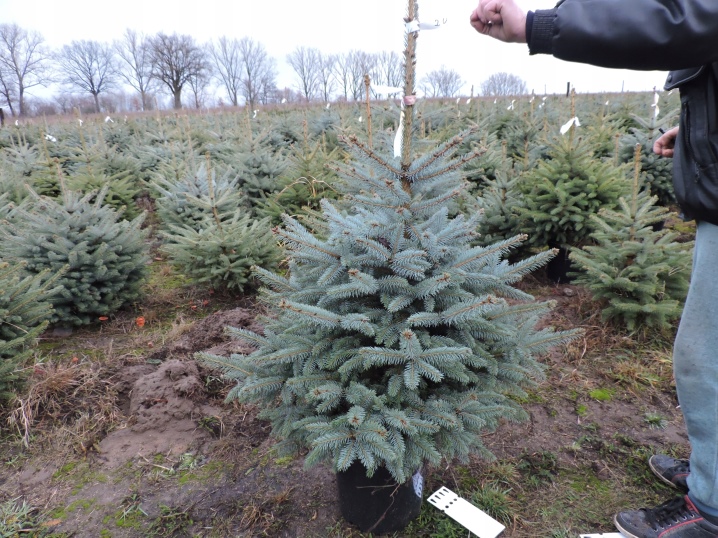
Due to the wide variety of varieties, the color of the needles can be very different. Even green has a ton of shades. The choice of a particular color is a matter of personal taste. Although it would be even more correct to consult with landscape designers before buying. Another important aspect is the size of the tree, which determines the convenience of handling spruce and the possibility of planting light-loving crops nearby.
Important: do not buy seedlings "off hand" or dig them up in the forest. This is simply stupid (it is not known how high-quality the plant will be), and independent harvesting of seedlings is also illegal. It is advisable to apply only to proven nurseries with a good reputation.
Seedlings with an open root system are acquired only if they are transplanted to their final place as quickly as possible. Container plants are chosen when they plan to transport them a long distance or wait more than a day after purchase.
Special attention should be paid to such a topic as the choice of a Christmas tree in a pot. It is undesirable to buy plants that are covered with a white bloom. They may look prettier than usual, but clogging the pores on the needles is unlikely to have a good effect on the plant itself. It is imperative to look at how healthy the culture is. Specimens with a dried substrate, with broken branches are strictly unacceptable.
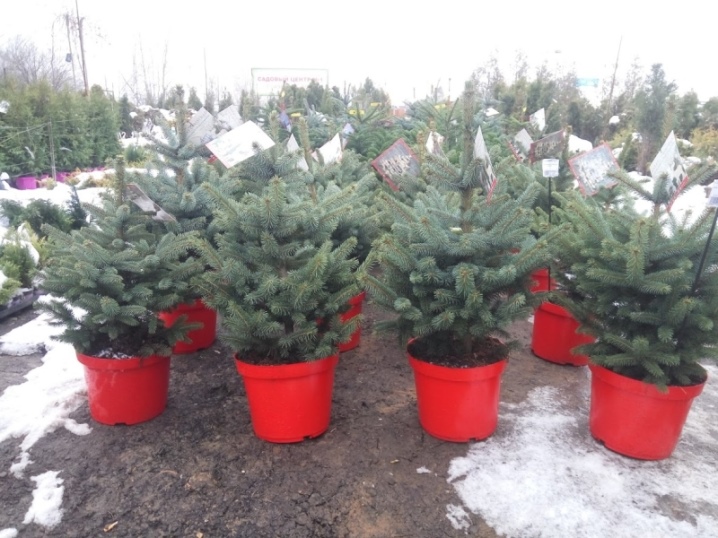
How to grow?
Seat selection and landing
It is very important to choose the right place on the site where the spruce will grow. It must be remembered that this plant is planted as far as possible from the garden - after all, it is susceptible to pest attacks. The size of the seedling is also taken into account. Miniature trees, reaching a maximum of 1.5-2 m, can be planted in open ground almost anywhere there is enough space. But tall specimens should be immediately placed where they will not interfere with anyone.
Large varieties of spruce, even if it is still a modest seedling, should not be placed next to the foundation of a house or other structure. Spruce roots are very strong and can destroy even brickwork or concrete. At the same time, a plant that is relatively modest in size can be planted. This even opens up a number of benefits:
- there will be cleaner and fresher air around the house;
- it is pleasant to look at a low decorative coniferous culture;
- excellent compatibility with other crops is ensured;
- it will be possible to celebrate the New Year by dressing up a living tree.

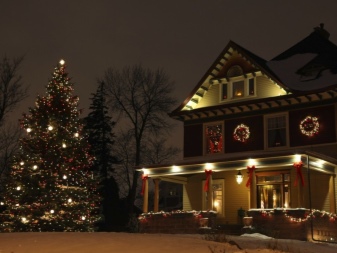
You should not trust the common "signs" about the incompatibility of conifers and the house. But the fact that planting a spruce next to lilacs is impractical is the correct recommendation. Low coniferous crops combine well with ornamental cereals. The best candidates for this are:
- feather grass;
- spikelet;
- fescue;
- miscanthus.
Conifers can also be combined with lush, profusely blooming perennial flowers. The early awakening of the coniferous corner is achieved through the use of primroses and bulbous crops. However, it is important for gardeners to know not only what plants can be grown next to the spruce. This culture is not too demanding for the light, but it is difficult to call it shade-loving in the full sense of the word.
Spruces can be planted both in sunny areas and in partially shaded areas, as long as their top is not shaded; 2-4 hours of illumination per day are enough for them.
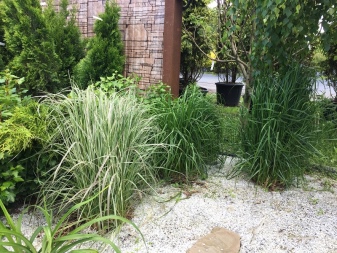
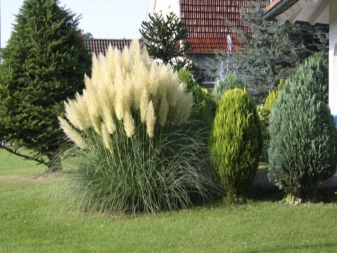
With a skillful approach, planting spruce is not difficult. In any case, it is no more difficult than planting any other tree. It is recommended to choose young growth (second year of life). It is best to plant spruce seedlings in the spring - at the end of April and in the first decade of May. Then the buds have not yet woken up, and therefore the plant will more easily tolerate the procedure.
Sometimes planting is carried out in late summer and early autumn, because then the roots are actively growing. If you need fertile soil. Better if it is loam or sandy loam. Since the root system is located close to the surface, it is imperative to avoid trampling and compaction of the earth. It is imperative to use a drainage layer with a thickness of 0.15-0.2 m.
The selected seedling is inspected and checked if the thin roots break. Living roots will bend when pressed lightly, but remain intact.
When cut, a pure white tissue is found. Gray and black cuts indicate that the tree is already dead and you need to look for another planting material.
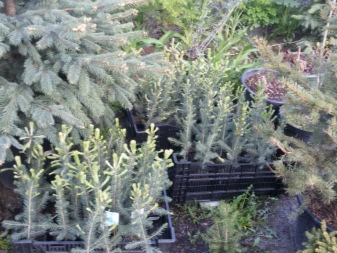
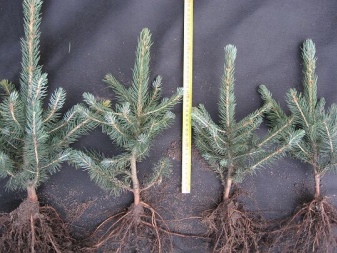
It is categorically unacceptable to take seedlings with thickened or covered with growths roots. These are sure signs of plant cancer that cannot be dealt with. Then they look that on the trunk - its bark and the bark of each branch should not have wrinkles. Yes, you can revive the planting material by soaking it for 2-3 days in water. However, this is unnecessary work and not always justified, because it is very easy to find fresh plants.
You also need to look so that there are no spots on the bark. In theory, they can be cut, but this will immediately complicate the subsequent shaping of the tree. Examine not only the bark and shoots, but also the top of the seedling. It should become woody and brown in color. It is not necessary to strive to buy planting material of the maximum height - it is much more correct to purchase a medium-sized tree.
The landing pit is prepared 13-14 days before the landing itself. Two-year-old seedlings need a recess 1 m deep and 0.6-0.7 m in diameter. Compost mixed with:
- bone meal;
- humus;
- needles.
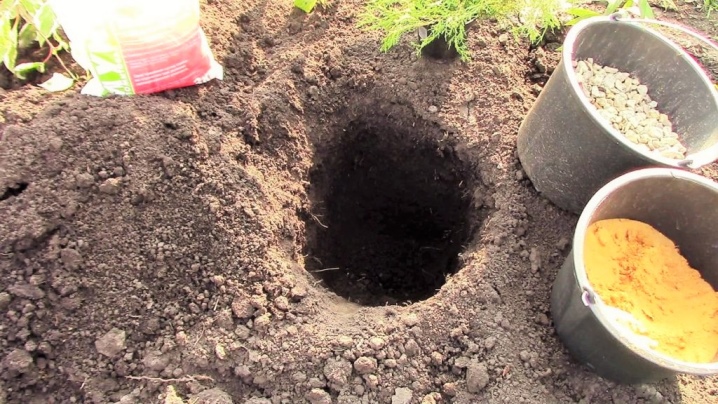
The earth lump, along with all the roots, should be freely placed in the hole. The roots are carefully straightened before filling the soil. Then the plant is raised and the earth is poured. It is thoroughly compacted to prevent subsidence. This is important because the root collar cannot go into the soil.
A peg is dug in near the planted Christmas tree, to which it is tied. Next, they create an earthen mound filled with sawdust. The newly planted bush is thoroughly watered.This will not only make up for the water deficit, but also eliminate air pockets that may appear by themselves. This is where the planting work ends.
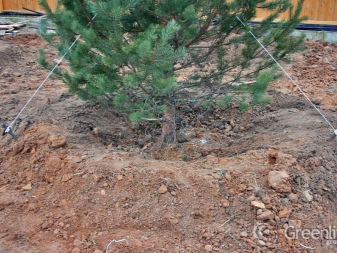
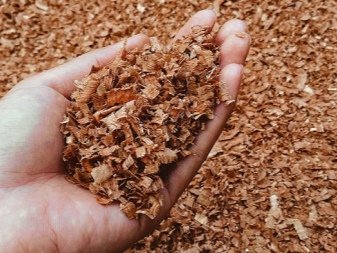
Watering
Despite the spruce's resistance to unfavorable environmental conditions, it must be watered in summer. At first, when the plant is just planted, it needs a lot of water. But you can't add too much liquid either. Clay soil is either mixed with sand, or drained thoroughly to eliminate stagnant water.
Water the plants every day. It is advisable to do this in the morning, while the sun is still low. Adult plants tolerate heat well, even for quite a long time. But if it is delayed or precipitation does not fall at all, then the plants must be helped by all means.
Sprinkling is carried out in the morning and in the evening, making a pause of 48 hours between procedures.
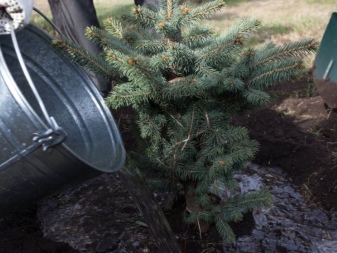
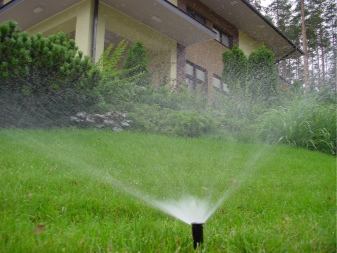
Pruning
The height of the plant is limited to your liking. To do this, you need to work with the top. The shoots located on top are twisted as soon as they arise. Then the nutrients will be evenly distributed over the remaining part of the crown. This will prevent the needles from dropping off the lower branches.
The difference between pruning and pinching needs to be learned clearly. The second option is suitable mainly for nursery staff, who can fully focus on working with trees. In households, a less time-consuming pruning procedure is preferred. In addition, plants grow much more slowly after pinching. Moreover, in some cases, pinching successfully replaces the sanitary pruning of young Christmas trees.
It is recommended to cut spruce with secateurs or garden saws. You need to remove the entire shoot or a deformed part of the trunk. Sanitary haircuts are carried out systematically, depending on how much the crown grows.
The older the tree, the more often it will need to be pruned. Experts consider the last third of summer to be the best moment for this.
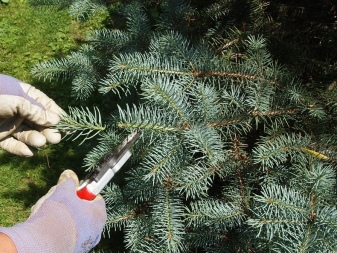

Pruning in the fall is also possible, but you will have to carefully calculate its timing so that the slices heal before the onset of frost. The reliability of such calculations, especially in today's unstable climate, is highly questionable. In any case, the next sanitary haircut should be carried out in the spring, before the buds begin to grow. Formative pruning is carried out only for trees not younger than 3 years old, when their height reaches 0.5-1 m. The pruning of the apical branches, stimulating lateral growth, helps to turn a plant like a cone into a kind of ball.
Young Christmas trees are often treated with pruning shears. For mature plants, try to use a hedge trimmer. It is advisable to perform a shaping haircut on cloudy days when there is no extreme heat. Otherwise, the needles will acquire an unpleasant brownish color. It is advisable to do a preliminary sprinkling in order to facilitate the work and keep the sharpness of the instrument longer.
Experts advise to focus on the natural lines of the crown of the tree, and not try to remake them - it will come out easier.
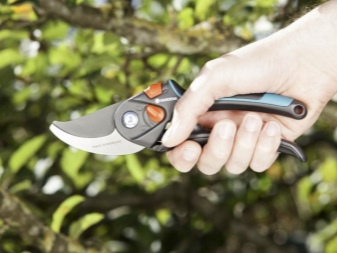
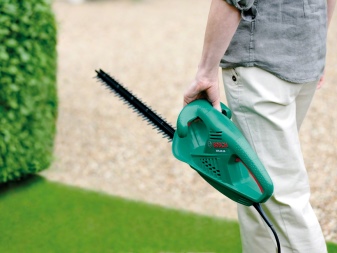
During the growing season, it is allowed to remove no more than 30% of the growth. Then the formation of a lush dense crown will be as easy as possible. It is strictly forbidden to leave the branches naked, because then their growth will be impossible. You also need to take care of your own safety. All parts of the body during work, especially the eyes and hands, must be carefully covered.
Additional requirements are as follows:
- cut the spruce only with a sharp, cleaned tool;
- after finishing work, wash its blades and wipe them dry;
- avoiding haircuts during resin excretion;
- do not strive to create a very complex geometric shape (this is the prerogative of professionals), because the simplest options can be no less attractive.

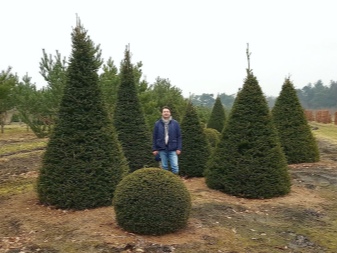
Top dressing
For all its unpretentiousness, the spruce definitely needs a supply of nutrients. Fertilizers with a high nitrogen content are categorically undesirable.They cannot be used for both planting and mulching. Growth stimulation is provided in a simpler way - using compost. In terms of 1 sq. m consume from 3 to 5 kg of compost.
It must be remembered that photosynthesis in conifers is weaker than in deciduous (less total foliage area affects). It can be improved with a small dose of magnesium. Therefore, for liming trees, dolomite flour is used, which compensates for the lack of this trace element.
But this composition alone cannot be dispensed with. It is imperative to use other mixtures containing Mg in a form that is easily assimilated by plants.
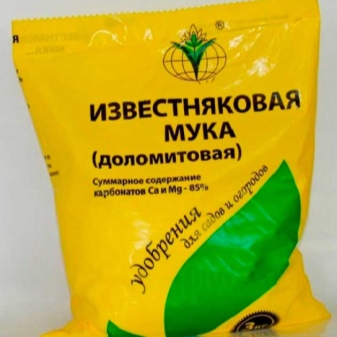
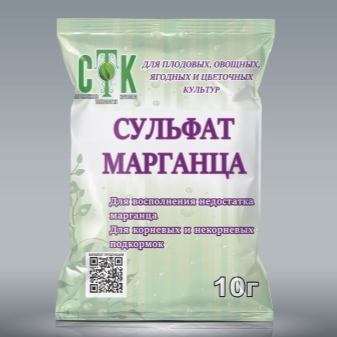
Choosing a fertilizer that has no nitrogen and enough magnesium is not enough. It must contain at least 10-12 microelements. Only then can feeding be done fully. The choice between Russian and imported fertilizers is not too fundamental. It is much more important that the composition meets the basic quality criteria.
Taking care of spruce in winter is not too difficult - you must first of all make sure that the branches are not overloaded with snow. They can even break from the load. In the first year of development, the plants must be covered. The necessary protection will be provided by an impromptu "wigwam" of several stakes, which are tied from above. The resulting "hut" is filled with spruce branches or covered with a film on the outside to reduce the snow load and make it more even.
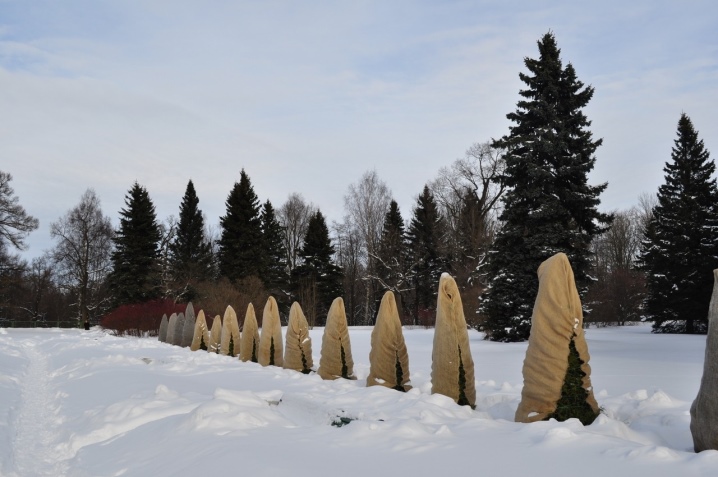
Diseases and pests
The appearance of yellowish spots and the falling of the needles on the spruce means that the plant is affected by the Sitka spruce aphid. You can detect harmful insects by knocking on a branch to which a sheet of paper is attached. It is possible to fight against aphids only when its “patrons” - ants - are eliminated. With a small number of aphids, problem areas are washed with soapy water. But you should protect the roots from the soap mixture.
Processing is carried out with an interval of 6 to 10 days. It is advisable to cut off all the tips of the affected shoots. When the needles bend and begin to turn yellow, and galls appear, there is a defeat by Hermes. Each of the galls can contain over 100 larvae.
There is no need for processing with synthetic drugs or improvised means. You just need to regularly remove all affected shoots.
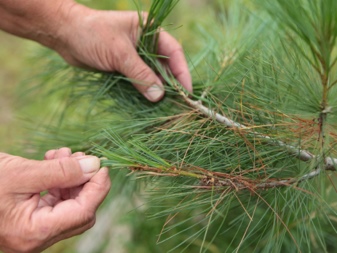
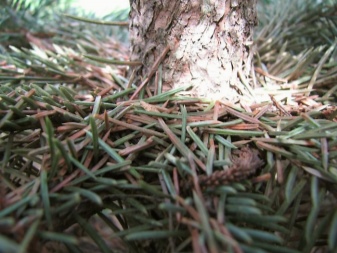
Insecticides are used only when the disease is severely spread. The needle-eater is a serious danger. This pest can only be recognized by feeling the needles. Sick branches are carefully, sometimes many times, treated with liquid soap or completely cut out. A very serious hermes infestation can be eliminated with broad-spectrum pesticides.
Spruce rust affects the needles, bark, cones. The fight against it is possible only by special treatment with the recommended drugs. Among them, Abiga-Peak and Fitosporin-M proved to be the best.
Lichen can cause twigs to dry out. A simple wooden scraper will help to remove foci of infection. Steel scrapers cannot be used - they deform the plant. For prevention in late autumn, trees are thoroughly whitewashed.
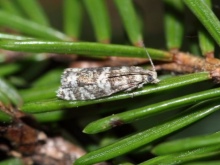
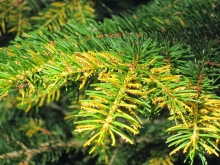
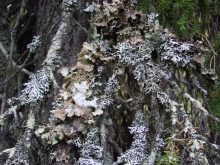
Spraying with a solution of copper sulfate at a concentration of 7 to 10% is also recommended. If the infection is mild, milk of lime is used. If the lichen has spread very widely, sanitary felling will be the only way out.
You also need to be afraid of such ailments as:
- shute;
- fusarium;
- root rot;
- plant cancer;
- rust buds.
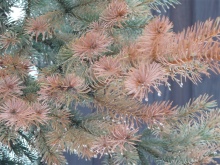
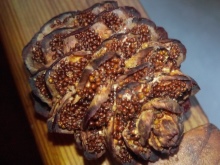
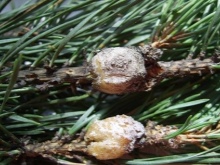
Possible problems
If the spruce needles have brightened, it can be assumed that this may be due to excessive rainfall or unreasonably active watering. Yellow and even white needles appear with a lack of iron. Lack of phosphorus often results in the needles turning purple; usually this problem concerns young needles. As for the browning of the needles, this is due to the infection of the rhizosphere with the fungus. To reduce the risk of infection, it is necessary to avoid excessive wetting of the needles.
When the spruce has thrown off its needles, the root aphid infestation is almost always the cause of the disease. It affects mainly young trees, and the chances of their salvation are very small. It will be possible to avoid the appearance of the disease by treating the soil coma with insecticides. This is very important due to the fact that it is almost impossible to prevent infections in nurseries. With room maintenance, the discharge of needles can be provoked by excessively dry and hot air.
Many people are interested in the abdomen how to lift the hanging branches. In fact, there is no point in this - the fact that the shoots look down is a natural natural state of the tree. The spacers will allow the branches to be lifted, but this is an artificial solution. In addition, they cannot be used for a very long time and will lead to the early death of the entire plant.
If the tree has two tops, then when planting, one of them is removed to the length of a new shoot, so that the plant develops beautifully and gracefully.
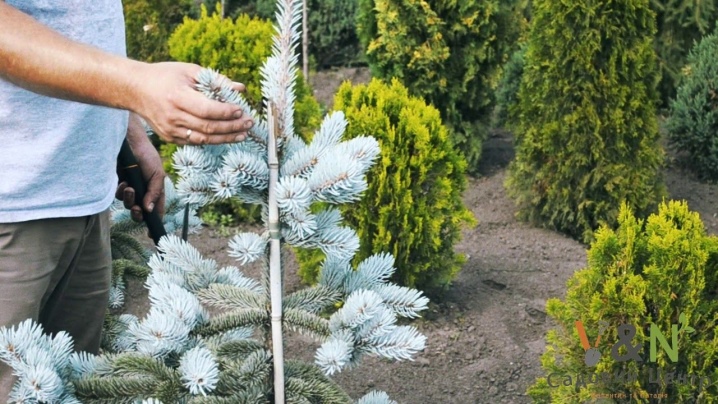
Preparing for winter
It is necessary to prepare the spruce for winter from the last decade of August. Already in the last month of summer, feeding is carried out without the addition of nitrogen, but with a predominance of phosphorus and potassium. Moisture-charging irrigation is carried out not earlier than the moment when the leaf fall of other crops ends. The circle to be watered should be at least equal to the diameter of the crown. Mulching of near-trunk circles is highly recommended, while mulch is laid out with a thickness of 0.05 m.
In the spring, the mulch will have to be removed. If this is not done, the roots will begin to rot. It is also necessary to take care of the support of the crown for the winter. Only in rare cases is it possible to shake off the snow manually after each snowfall. If the crown has a pyramidal shape, it is tied in a spiral from the bottom up.
At the same time, it is not recommended to tighten too much - the main thing is that the branches are stably in their natural position. It is generally inappropriate to tighten multi-stem trees: they are simply fixed with a strong rope. Creeping varieties of fir trees are protected differently: stones that create the necessary support are placed under the skeletal branches.
It is strictly forbidden to replace stones with planks, logs, pieces of logs or thick branches - all wooden materials will rot. Young plants with thin vertical trunks are secured with support stakes and stretch marks.
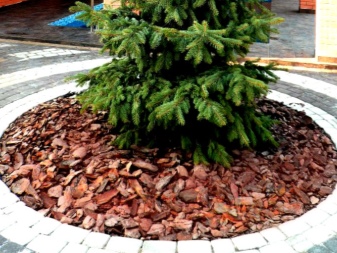

Immediately before the beginning of winter, it is imperative that all coniferous crops be treated from harmful insects and pathologies. Copper-containing preparations provide the necessary protection against disease. To avoid damage by pests, use "Actellik". Pruning spruce trees in the fall, especially in the second half, is undesirable. Even hedges only form in the spring; it is allowed to remove only deformed and broken shoots if they cannot be healed.
To ensure that the conifers are reliably protected from the sun, they are shaded from the south. But a much more correct measure would be full cover with covers. Do not use polyethylene and non-woven materials for shelter. Because of them, the crown can vomit, and this always ends up sadly for the plant.
It is recommended to use gauze or sackcloth. Removal of shelters should only take place after the soil has thawed.
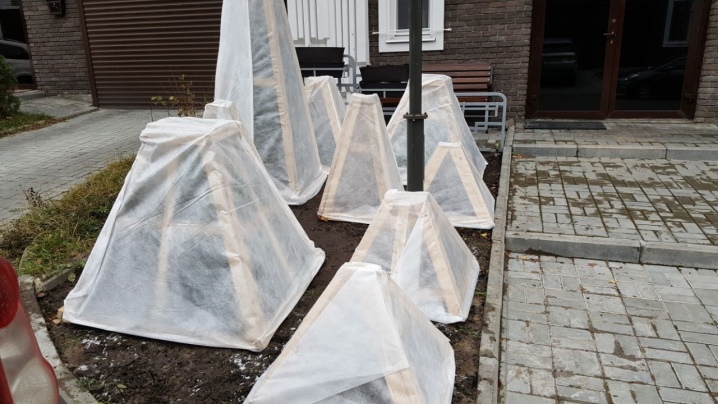
How to propagate?
If a spring planting of seeds is chosen, they must be stratified in the snow for 30 to 120 days. Before planting, the planting material is soaked for 12 hours in a solution of trace elements. Sowing is carried out immediately after warming up the earth. Seedlings can be expected after the end of frost. The development of seedlings in the same place will take 1-2 years, and then they are transplanted to the final place.
Before purchasing seeds, make sure they are fully conditioned. Seedlings with closed roots can be grown not only in containers, but also in polyethylene rolls. A prerequisite for success is picking.
But you can use another technique - cuttings.Winter cuttings are planted in spring when buds of other plants swell. In 3-5 months the roots will grow up to 0.2 m. It is recommended to maintain the temperature in the ground (at a depth of 0.05 m) from 13 to 20 degrees. At the same time, the air warms up to 10-19 degrees. In the greenhouse they lay out a "pie" from:
- fine gravel (0.05 m);
- turf land (0.1 m);
- combinations of 1 part peat with 3 parts washed quartz sand.
The finished greenhouse is watered so that the water saturates the "cake" from top to bottom. Cover the greenhouse with a frame with glass or film. Cuttings should be planted at an angle of 20 to 30 degrees to a depth of 0.01 m.
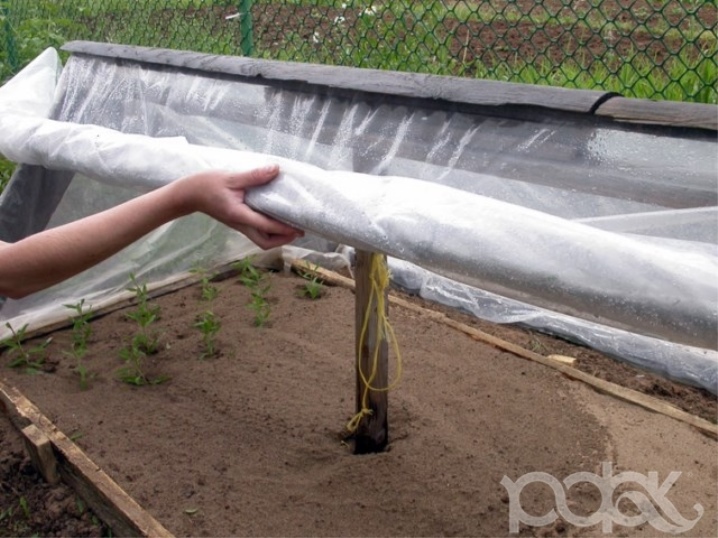
To create a shading effect, cheesecloth is laid out on top.
Beautiful examples in landscape design
It would take a long time to describe the ate and paint the way with them. But it is much more interesting how a composition with them on a plot in a garden or near a house can look like. The photo below reveals all the beauty of the yellow-green spruce, set off by a white plant carpet. On the other side of the frame is another miniature coniferous plant. Let its color be more familiar, but the grace is beyond doubt.
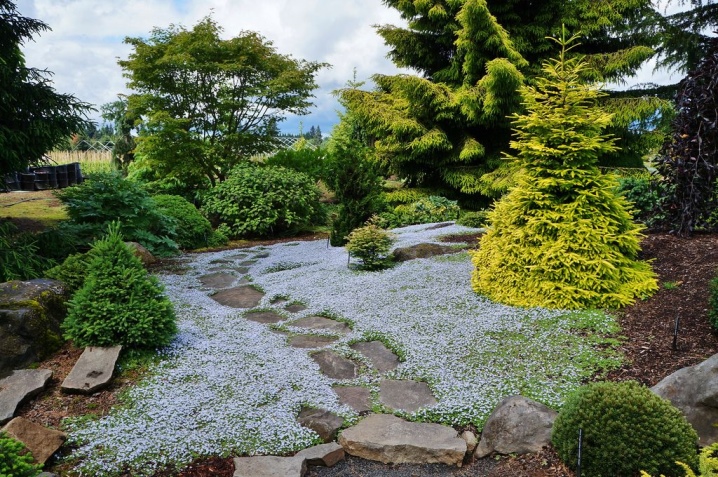
But you can do otherwise, using a relatively tall bluish spruce. In this case, it becomes the dominant feature in a separate area of the garden plot.
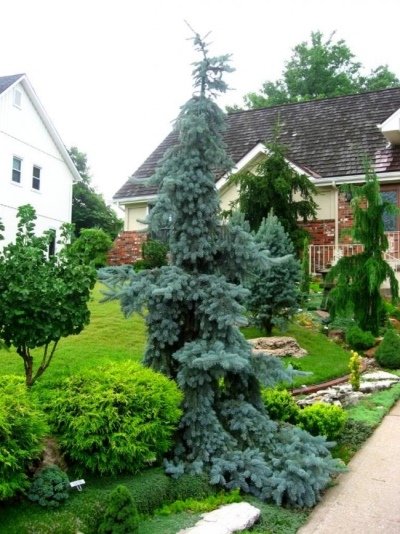
And here a decision was made that was completely out of the traditional range - conifers set off a completely artificial background. They are used as local decorative accents around the garage entrance. And, I must admit, it turns out not so bad in appearance.
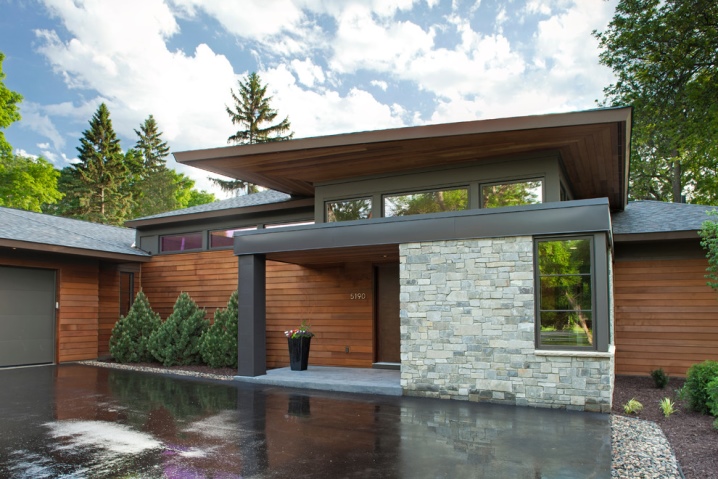
The undersized Nidiformis shrub shown in this photo has been used to form an original rock garden. A plant located on a dais immediately catches the eye of the observer.
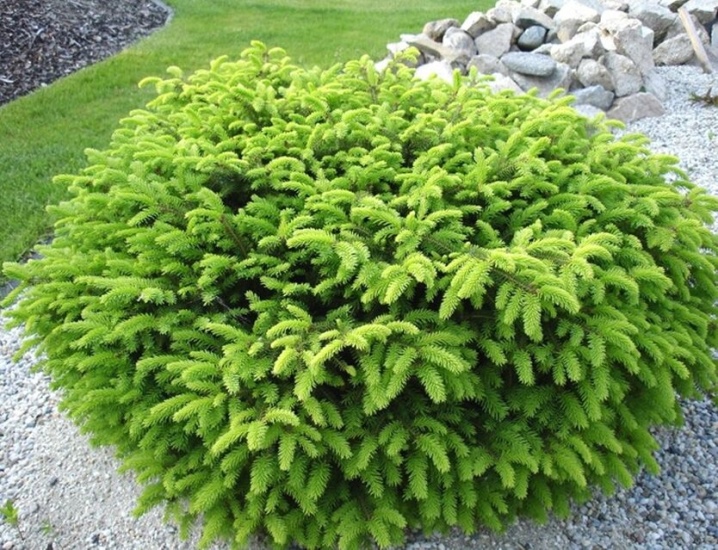
But this is how another version of a rock garden, decorated with the help of stunted conifers, may look like. Despite the seeming randomness, the thoughtfulness of the composition can be recognized by the geometry. Take, for example, the verified color and geometric balance of its constituent parts.
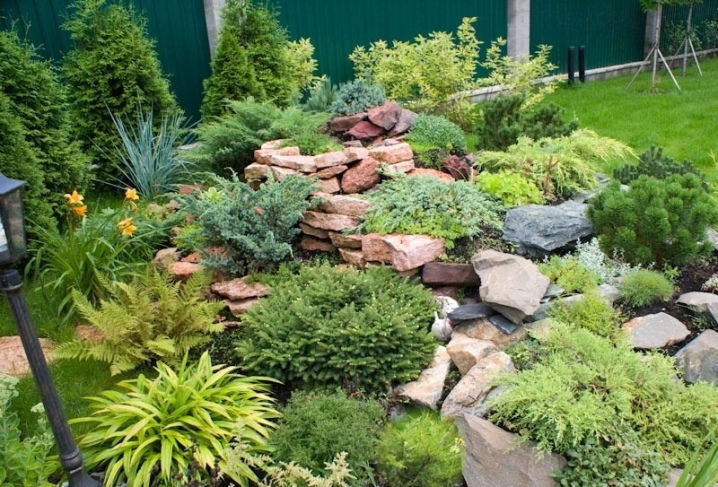
How to plant and care for spruce, see below.



































































The comment was sent successfully.